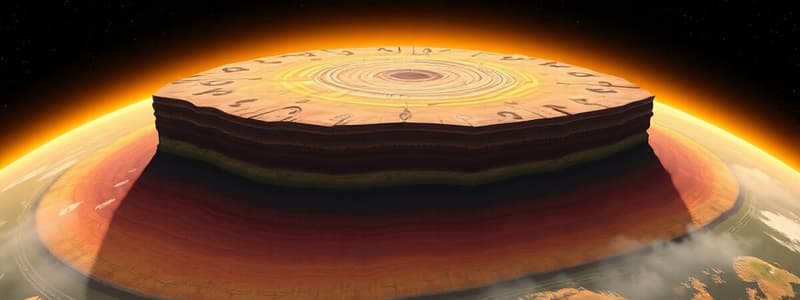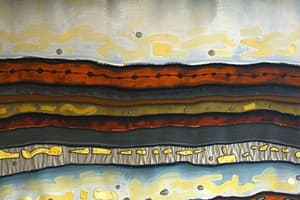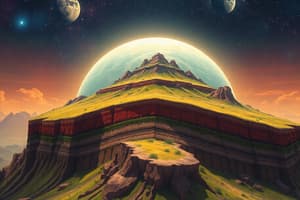Podcast
Questions and Answers
What is the approximate distance from the surface to the center of the Earth?
What is the approximate distance from the surface to the center of the Earth?
- 7,500 km
- 7,000 km
- 6,500 km (correct)
- 6,000 km
S-waves can travel through both solid and liquid materials.
S-waves can travel through both solid and liquid materials.
False (B)
What scientific study focuses on earthquakes and volcanic eruptions?
What scientific study focuses on earthquakes and volcanic eruptions?
Seismology
A mineral is a solid, naturally occurring, crystalline object with a defined chemical __________.
A mineral is a solid, naturally occurring, crystalline object with a defined chemical __________.
Match the types of seismic waves with their characteristics:
Match the types of seismic waves with their characteristics:
Which program focuses on scientific ocean drilling?
Which program focuses on scientific ocean drilling?
All solids are considered minerals.
All solids are considered minerals.
How do seismologists use seismic waves to study Earth's interior?
How do seismologists use seismic waves to study Earth's interior?
What is the lithosphere primarily composed of?
What is the lithosphere primarily composed of?
The lithosphere includes the entire mantle.
The lithosphere includes the entire mantle.
What layer of Earth is known to be the semi-fluid layer beneath tectonic plates?
What layer of Earth is known to be the semi-fluid layer beneath tectonic plates?
The __________ is about 2,900 km below Earth's surface and is made mostly of iron and nickel.
The __________ is about 2,900 km below Earth's surface and is made mostly of iron and nickel.
Match the following layers of Earth with their properties:
Match the following layers of Earth with their properties:
What is the thickness range of the Earth's crust?
What is the thickness range of the Earth's crust?
The mantle accounts for about 85% of Earth's volume.
The mantle accounts for about 85% of Earth's volume.
What phenomenon is caused by molten rock being forced to the surface during a volcanic eruption?
What phenomenon is caused by molten rock being forced to the surface during a volcanic eruption?
Flashcards
Earth's Core Distance
Earth's Core Distance
The Earth's core is approximately 6,500 kilometers from the surface.
Lithosphere
Lithosphere
The solid outer layer of Earth, composed of rocks, minerals, and the crust and upper mantle.
Seismic Waves
Seismic Waves
Vibrations that travel through the Earth, often caused by earthquakes.
Earth's Crust
Earth's Crust
Signup and view all the flashcards
P-waves
P-waves
Signup and view all the flashcards
Oceanic Crust
Oceanic Crust
Signup and view all the flashcards
S-waves
S-waves
Signup and view all the flashcards
Continental Crust
Continental Crust
Signup and view all the flashcards
Mantle
Mantle
Signup and view all the flashcards
Outer Core (State)
Outer Core (State)
Signup and view all the flashcards
Asthenosphere
Asthenosphere
Signup and view all the flashcards
Seismology
Seismology
Signup and view all the flashcards
Convection Currents
Convection Currents
Signup and view all the flashcards
Mineral Definition
Mineral Definition
Signup and view all the flashcards
Mineral Physical Properties
Mineral Physical Properties
Signup and view all the flashcards
Plate Tectonics
Plate Tectonics
Signup and view all the flashcards
Crystal Structure
Crystal Structure
Signup and view all the flashcards
Tectonic Plates
Tectonic Plates
Signup and view all the flashcards
Drilling and Earth's Interior
Drilling and Earth's Interior
Signup and view all the flashcards
Earth's Core
Earth's Core
Signup and view all the flashcards
Study Notes
Earth's Layers
- Earth has several layers with distinct properties.
- The lithosphere is the uppermost solid layer, comprising the crust and upper mantle.
- The lithosphere extends from the surface to 50-280 km below.
- It's mainly composed of rocks, minerals, and solid ground.
Crust
- The crust is Earth's outermost, thin layer (5-70 km thick).
- It accounts for only 1% of Earth's mass.
- Two types exist: oceanic (thin, dense) and continental (thick, less dense).
Mantle
- The mantle is a thick layer (2,900 km) making up 85% of Earth's volume.
- Divided into upper and lower mantle.
- The upper mantle (asthenosphere) is semi-molten rock flowing in convection currents.
- The mantle is dense, iron-rich, and hotter than the crust.
Core
- The core is the innermost layer, located 2,900 km below the surface.
- Composed of an outer and inner core.
- Mostly iron and nickel, with the inner core being solid due to immense pressure.
- The center of Earth is approximately 6,500 km from the surface.
Plate Tectonics
- The lithosphere is divided into rigid plates.
- Plates float/rest on the asthenosphere.
- Plate movement is driven by convection currents within the mantle.
- Plates can collide, slide past, or separate.
Studying Earth's Interior
- Seismologists use seismic waves (P-waves & S-waves) from earthquakes to study the inner structure.
- P-waves travel through solids and liquids; S-waves only travel through solids.
- The behavior of seismic waves helps determine the composition and state of each layer.
- Scientists also drill into the crust to study its structure.
Minerals
- A mineral is a naturally occurring, crystalline solid with a defined chemical composition.
- Minerals have a regular internal crystalline structure.
- Key physical properties include luster, hardness, cleavage, fracture, magnetism, density, and acid reaction.
- Water is not a mineral as it's liquid, unlike solid minerals.
Studying That Suits You
Use AI to generate personalized quizzes and flashcards to suit your learning preferences.




